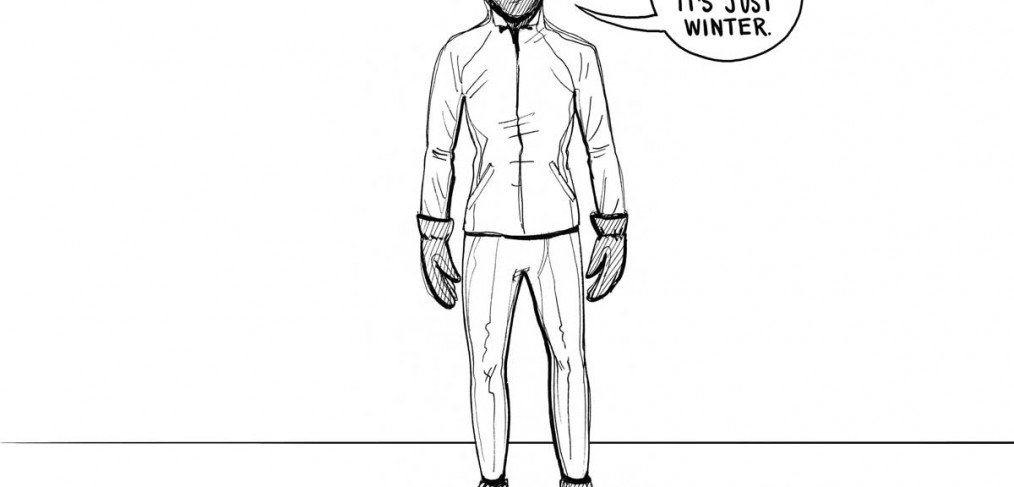
Warm Winters
Way back in my first winter in Massachusetts I commuted by car. It sorta went like this:
It was easy to never be dressed for weather. And easy to misplace things like gloves.
Once I moved into the city that changed. Even before I started biking I found myself walking an average of 4 miles a day to get to public transit and everywhere in in between. It was horribly cold. Then I realized the weather wasn’t bad. My clothing was. All my disposable fashion was just that, disposable.
However, it’s not always easy to find good winter wear these days:
I suspect many fashion designers are drivers. And live in Los Angeles. They’re not designing for my lifestyle.
I need functional fashion. And it doesn’t have to look like this:
There are some warmer winter options out there if you really look. I still make sure to pay attention to the details:
Because there is a difference between looking warm and being warm.
So after several winters in the city I have finally built up a quality winter wardrobe of quality winter items and approach that works for me:
Winter is much warmer now. And I no longer lose my gloves.

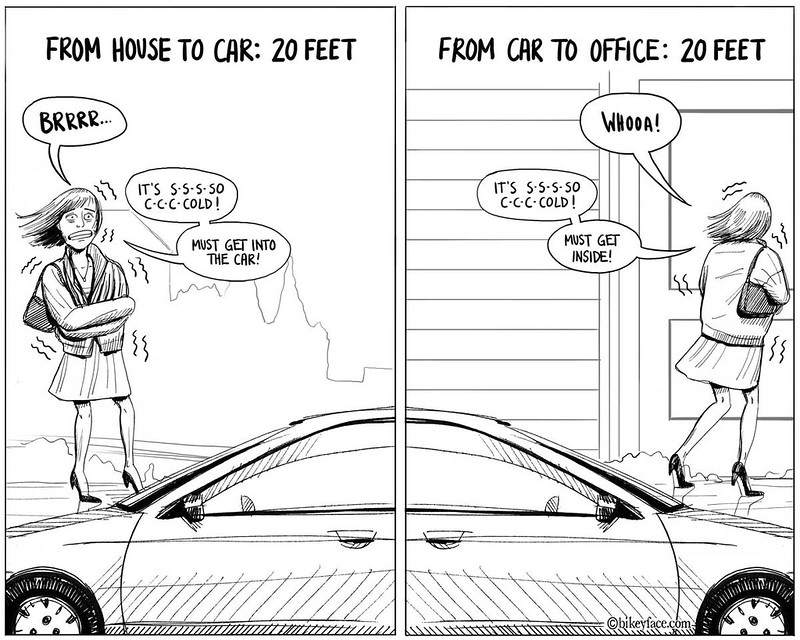
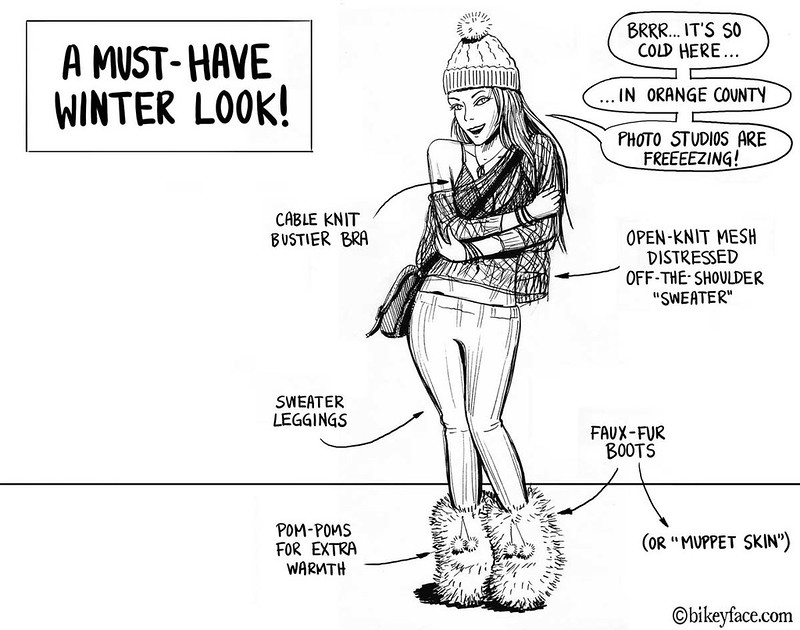

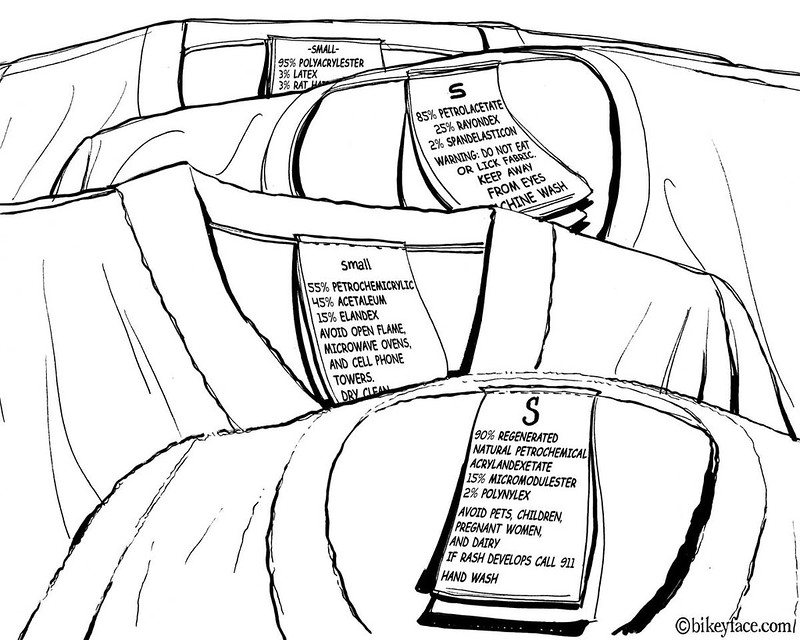
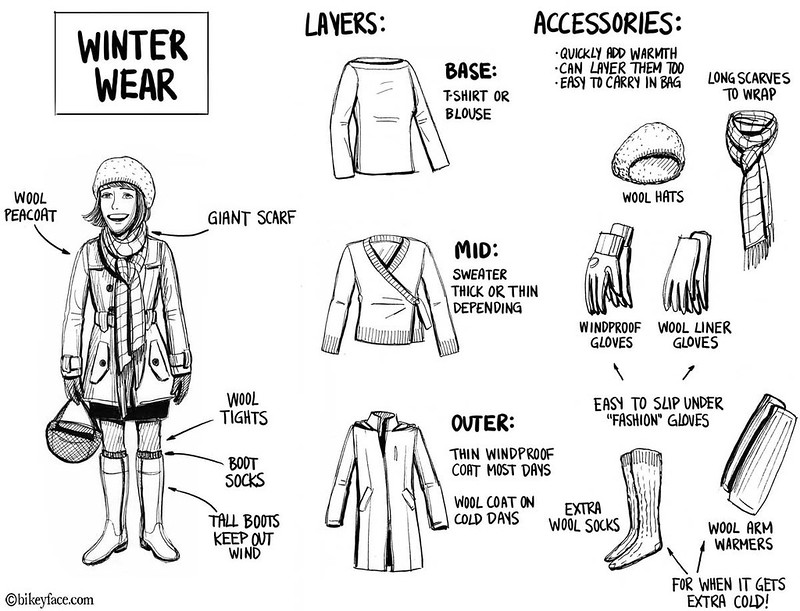


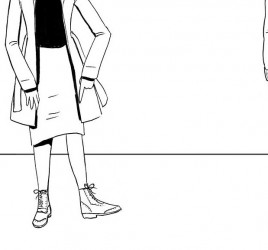
You’re missing something from your otherwise really cool list of women’s cold weather cycling fashion. Maybe you could have included a wool skirt or shorts?
Thank you for winter wear tips… You awesomeness just gets better…
Men want you… Women want to be you. 🙂
You like wool better than synthetics. I get it. There are a lot of benefits to wool. There are also a lot of benefits to synthetics. Some of which wool doesn’t have. I also get that the cartoon about the base layer tags is a joke, but I think it is also a disservice. My synthetic polypro has held up for years and years and years. It is easier to wash than wool. It doesn’t have special washing instructions, and it certainly doesn’t come with any of those warnings. And when you move past base layers, synthetics will provide more warmth ounce for ounce than wool. And finally, synthetics will dry much faster than wool.
Wool’s cool too, but you seem to be implying that there are heath hazards and fussy washing instructions for synthetics, and I just don’t think that is true. If anything, it is wool that has the fussy washing instructions. If you look at it wrong, it will shrink to an unusable size.
I took the part about synthetics to be in reference to women’s “winter” fashion, not performance synthetics (like underarmor, capilene, etc.). Because when you go to a women’s clothing store, and you go to the “sweater” rack, all the sweaters are acrylic with maybe some cotton. NOT good warmstuffs
Josh, what you say about wool is historically true, but does not apply to modern superwash-process wool, such as is sold by the likes of Smartwool, Ibex, and Icebreaker among others. I confess to being a hardened lanophile, with more than 90% of my wardrobe being 100% wool, all layers, and most of the remainder being mostly wool with a bit of strategic elastic or nylon here or there. I bike every day year round, summer too in sheer wools.
I machine wash and dry all of it. It dries very fast indeed, especially after a high-speed spin cycle. Right now I am wearing one of 4 pair of merino long underwear bottoms I have owned since 2004, that I wear every day from October to May. 2 of them have small holes, otherwise like new. Most of the rest of my clothes are newer, but I have similar longevity expectations.
My experience of synthetics is that body odors build up very rapidly in them, and can be very tenacious even with aggressive detergents. I have itchy rash reactions to many sorts of it (as I know some people do even with the softest wool), which made me chuckle in response to BF’s panel about labels. Meanwhile wool is famously resistant (though not immune) to body odor. This means that I can wear it a few times before washing is necessary. This means I spend less time and energy (my own and the power company’s) caring for it than other fabrics.
Synthetics are warmer ounce for ounce? I didn’t know that, but one of the things I like about wool is its heft: its own weight gives it a nice drape so wrinkles hang out with a body’s subtle perspiration. That extra weight means thermal inertia too; it holds warmth well in and out of heated spaces, in drafts etc, feeling cozier. Depends on the structure of the fabric I suppose, but I suspect strongly that wool is a lot warmer than most synthetics by volume/bulk, if not by weight. Who wants bulk?
Finally one of the things I disliked about synthetics is their amazing static electricity generative powers. Had me all jumpy waiting for the CRACK around metal objects.
What good superwash merino and similar wool garments have are high price tags. I admit that. But given their performance, longevity, colorfastness, versatility, and low-resource care, I consider them a bargain in the end.
I nearly expected her to be chic….on the bike. 🙂 After several days of spring-like cycling, about 6 cm of snow dumped on us.
We get winters plunging down to -25 degrees to -30 degrees C. or colder here in southern Alberta. I’ve given up buying fashionable clothing from regular women’s stores. Sporting goods or quality fitness wear for me ..to get to work.
It’s a nice post, Bikey (I hope you don’t mind my using your first name). I moved in August from London to New York City and have been bracing myself (as I related here: http://invisiblevisibleman.blogspot.com/2012/11/whatever-weather-cyclings-proved-post.html) for a tough winter’s cycling. After three successive harsh winters in London in recent years, I have a pretty comprehensive kit of light waterproof jacket, full-finger gloves, waterproof trousers and so on for when the weather’s really harsh. They all go in my right-hand pannier bag (the left-hand one is for my jacket, a jumper, work notebooks, lights and so on).
The problem at the moment is I actually don’t need any of it. This morning, I’ve just done my nine miles from Brooklyn to mid-town Manhattan wearing my work shirt with the sleeves rolled up, a high-visibility vest and half-finger gloves. I’m more worried about arriving sweaty than getting cold. I’m almost disappointed.
All the best,
Invisible.